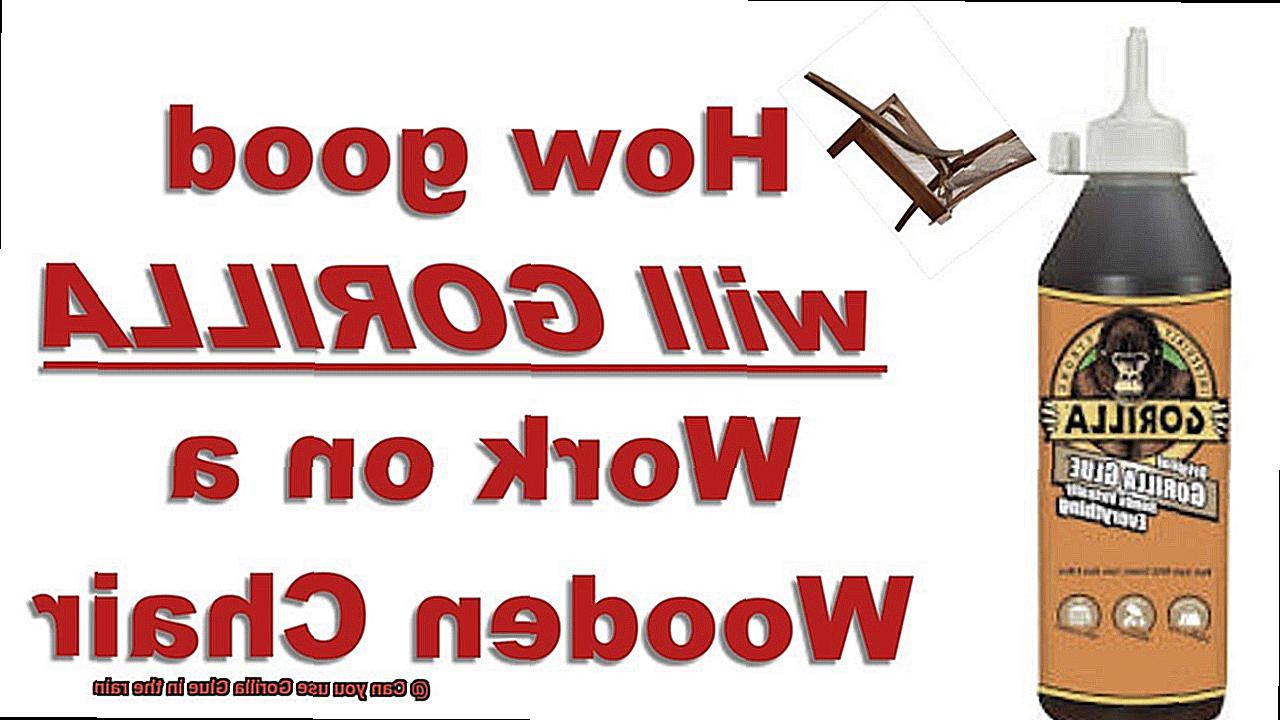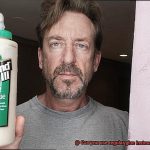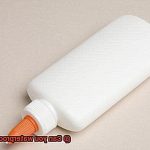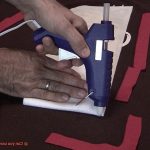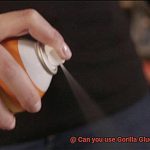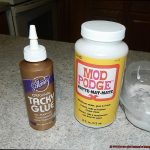Imagine this: You’re in the middle of a DIY project, and it starts pouring rain. Suddenly, you realize you need Gorilla Glue to finish the job. But can you use Gorilla Glue in the rain? Fear not, my friend. As an expert on this subject, I’m here to give you all the answers.
Gorilla Glue is a go-to adhesive for many projects, but using it in wet conditions can be tricky. Rain is unpredictable, so it’s crucial to know how to prepare for unexpected weather.
In this blog post, we’ll dive into the characteristics of Gorilla Glue and whether or not it can withstand rainy weather. Plus, I’ll share some tips on how to use Gorilla Glue successfully in wet conditions and address common concerns about using this adhesive in the rain.
By the end of this article, you’ll have all the information needed to carry on with your DIY project even during a downpour. With confidence that your project will remain intact despite any weather challenges. So let’s get started.
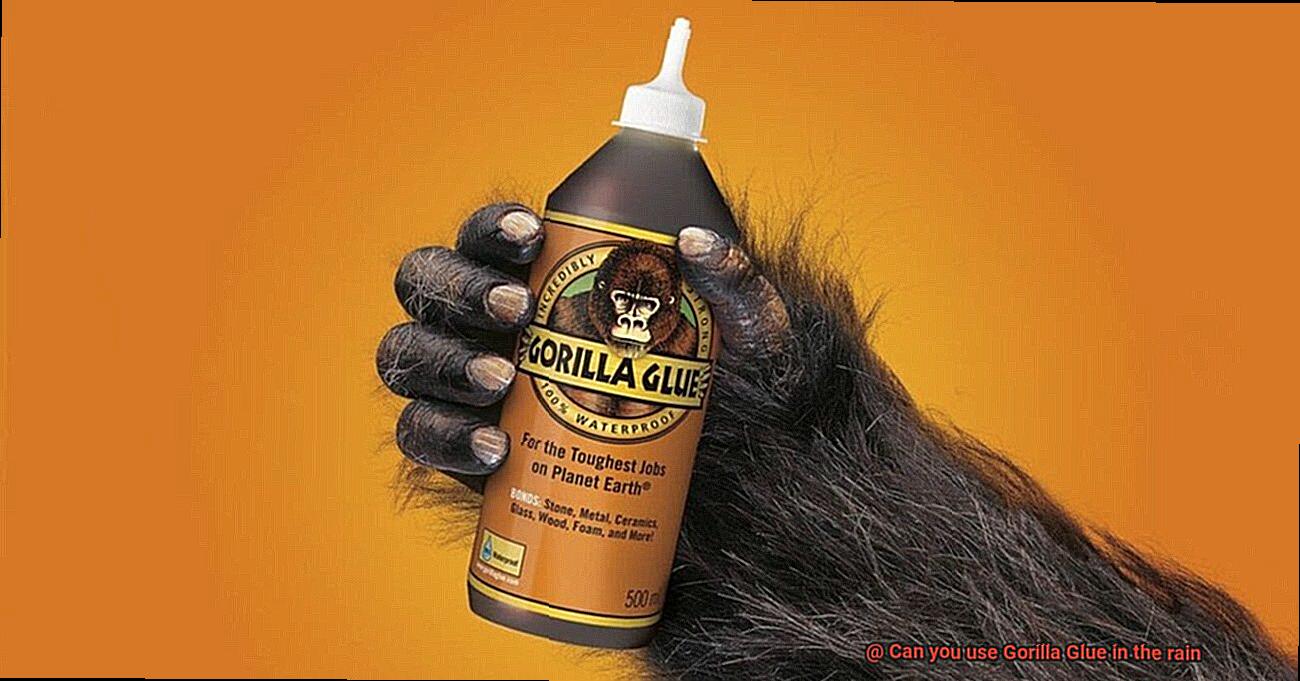
Can Gorilla Glue be Used in Wet Conditions?
Contents
- 1 Can Gorilla Glue be Used in Wet Conditions?
- 2 How Does Gorilla Glue Work?
- 3 Why Is Gorilla Glue Not Recommended for Use in Rainy or Wet Conditions?
- 4 What Are the Potential Negative Effects of Using Gorilla Glue in Rainy or Wet Conditions?
- 5 Can Gorilla Glue Be Used in Light Rain or Damp Conditions?
- 6 How to Apply Gorilla Glue in Light Rain or Damp Conditions?
- 7 Conclusion
However, one of the most frequently asked questions about this popular glue is whether it can be used in wet conditions. The answer is yes, but there are some crucial factors to consider to ensure a strong and lasting bond.
Firstly, it’s important to understand how Gorilla Glue works. It’s activated by moisture, which causes it to foam and expand, increasing its bonding strength. However, over-saturation with water can dilute the glue and weaken its adhesive properties. So, when using Gorilla Glue in wet conditions, avoid over-saturating the glue with water.
Another crucial factor to consider is the surface you’re bonding. Gorilla Glue is most effective on porous surfaces such as wood, stone, and ceramic. If you’re trying to bond non-porous surfaces such as metal or plastic, it may not work as well in wet conditions.
To ensure optimal results, it’s essential to prepare the surface before applying the glue. Clean and dry the surface thoroughly to remove any dirt, grease, or moisture that could interfere with the bonding process.
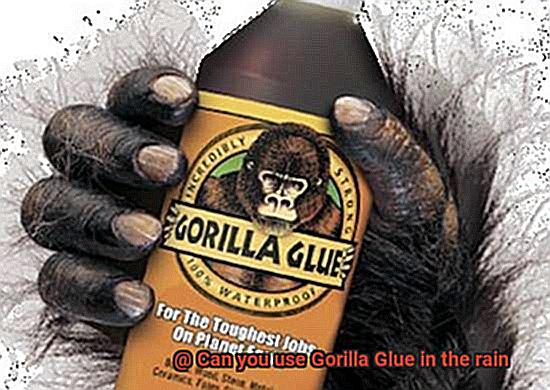
If you need to use Gorilla Glue in light rain or damp conditions, there are some tips you can follow to ensure a strong bond. Apply a thin layer of glue and clamp the two surfaces together tightly. Clamping helps force out excess moisture and allows the glue to cure correctly.
How Does Gorilla Glue Work?
When it comes to strong and durable adhesives, few can match the power of Gorilla Glue. But how does this polyurethane-based adhesive work its magic, and what are the best conditions for using it?
At its core, Gorilla Glue works by reacting with moisture. When applied to a surface, the glue will expand and create a foam-like substance that fills any gaps in the material it is bonding. This process is called cross-linking, resulting in an incredibly strong and long-lasting bond. What’s more, Gorilla Glue can bond with a wide range of materials, including wood, metal, ceramic, stone, and more. It can even bond dissimilar materials together, such as metal to plastic or wood to glass.
However, for Gorilla Glue to work effectively, it needs moisture to activate. This means that the surfaces being bonded must be slightly damp before applying the glue. If the conditions are too dry or there is no moisture present, the glue may not work as well. To ensure a strong and lasting bond, it’s also important to prepare the surface before applying the glue by cleaning it thoroughly and ensuring that it is free of dust and debris.
To get the most out of Gorilla Glue, it’s crucial to use clamps to hold the two surfaces together tightly while the glue sets. This will help ensure that the bond created by the glue is as strong as possible. Applying a thin layer of glue is also important for maximum effectiveness.
While Gorilla Glue can be used in wet conditions, there are some precautions to keep in mind. Too much water can weaken its adhesive properties, and non-porous surfaces might not bond as well. However, if you prepare the surface properly by cleaning it and applying a thin layer of glue before clamping it tightly together, Gorilla Glue will activate with moisture and create a strong and lasting bond.
Why Is Gorilla Glue Not Recommended for Use in Rainy or Wet Conditions?
Think twice before proceeding. As an expert, I can tell you that using Gorilla Glue in rainy or wet conditions can lead to a weak bond and uneven curing. Here’s why:
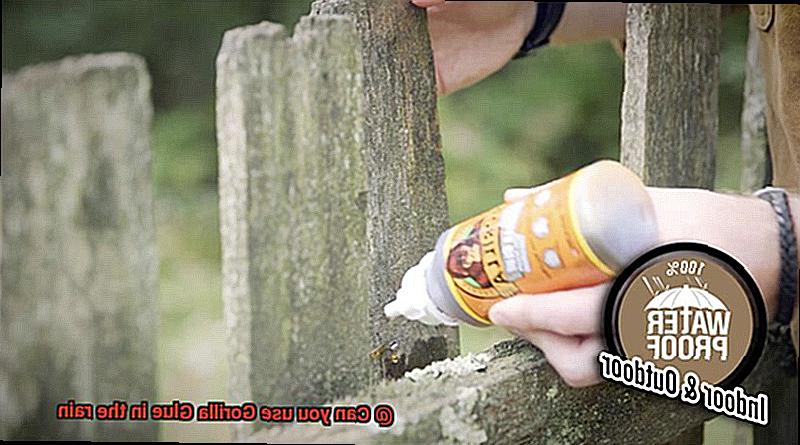
Firstly, Gorilla Glue requires moisture to cure properly. It reacts with water to create a foam-like substance that fills gaps and creates a robust bond between materials. However, using it in excessive water can cause the glue to foam up excessively and lose its adhesion properties.
Moreover, the presence of water can dilute the glue and weaken its overall strength. This implies that even if the glue appears to be holding up initially, it may not be able to withstand the test of time.

Thirdly, temperature plays a crucial role in the performance of Gorilla Glue. The optimal temperature range for this adhesive is between 70°F and 100°F. Rainy or wet conditions are often associated with lower temperatures, which can negatively impact the glue’s curing time and strength.
Furthermore, using Gorilla Glue in rainy or wet conditions can lead to uneven curing. The glue may dry too quickly in some areas and not enough in others, which can weaken the bond and lead to failure over time.

So, what should you do instead? Here are some tips:
- Check the weather forecast before using Gorilla Glue
- Avoid using it on rainy or wet days
- Wait for a dry day to use Gorilla Glue or find an alternative adhesive that is specifically designed for use in wet environments
What Are the Potential Negative Effects of Using Gorilla Glue in Rainy or Wet Conditions?
If you’re planning on doing some DIY projects in rainy or wet conditions, it’s important to consider the potential negative effects of using Gorilla Glue. As an expert in adhesives, I’m here to give you the lowdown on what to watch out for.
First and foremost, let’s talk about drying time. When Gorilla Glue is exposed to moisture during the drying process, it can slow down or even prevent the glue from fully drying. This can result in a weak bond or no adhesion at all. So, if you’re thinking about using Gorilla Glue on a rainy day, it’s best to wait for better weather conditions.
Another thing to watch out for is foam and bubbles. When Gorilla Glue comes into contact with moisture, it can expand and create bubbles or foam. This can cause the glue to lose its shape and not adhere properly. To avoid this issue, make sure you don’t apply too much glue and allow it enough time to dry before exposing it to water.
In addition, wet surfaces can also affect the strength of the bond created by Gorilla Glue. The glue needs a dry surface to create a strong hold, and wet surfaces can prevent that from happening. So, if you’re trying to bond two items together on a rainy day, you may want to wait until things dry out a bit before applying the glue.
Can Gorilla Glue Be Used in Light Rain or Damp Conditions?
Don’t let the fear of rain or dampness dampen your spirits. As an expert in adhesives, I am here to guide you through using Gorilla Glue in light rain or damp conditions like a pro.
Gorilla Glue is unique because it is activated by moisture. This means that it actually works better in damp conditions than in dry ones. However, it’s important to note that the glue needs to be applied to a dry surface initially. Otherwise, the moisture in the surface can cause the glue to foam and expand, affecting its bonding properties.
To avoid this issue, you must prepare the surface beforehand. Begin by wiping it down with a dry cloth and allowing it to air dry completely before applying the glue. This simple step can prevent the glue from reacting negatively with the surface and ensure a strong bond.
When using Gorilla Glue in damp conditions, do so indoors or in a sheltered area where it won’t be exposed to direct rainfall. This will prevent any consistent exposure to moisture that could compromise the glue’s effectiveness.
It’s crucial to remember that Gorilla Glue is not waterproof. Although it can withstand some water exposure, consistent exposure to moisture will cause it to break down over time. If you require a waterproof bond, using a specialized adhesive designed for this purpose is recommended.
How to Apply Gorilla Glue in Light Rain or Damp Conditions?
Gorilla Glue is a powerful adhesive that requires some level of moisture to activate and cure properly. However, too much moisture can actually weaken the bond strength and curing time of the glue. So, if you need to use Gorilla Glue in light rain or damp conditions, there are some precautions you need to take.
Preparing the surfaces you plan to bond is crucial. Make sure they are as dry as possible before applying the glue. You can wipe them down with a clean, dry cloth or let them sit in a dry area for some time. This will ensure that the glue can penetrate the material and create a strong bond.
When applying the glue, remember that less is more. A small amount is enough to create a strong bond. Apply it evenly over one surface using a brush or applicator, covering the entire bonding area.
Press the two surfaces together firmly and hold them in place for at least 10-15 seconds. Applying enough pressure is important, but be careful not to squeeze out too much glue or create excess mess.
It’s also important to avoid applying Gorilla Glue in heavy rain or when water is actively pooling on the surface. This can dilute the glue and prevent it from curing properly. If possible, create a sheltered area where you can work on your project without exposing it to additional moisture. Alternatively, use a tarp or other waterproof covering to protect the project while the glue is setting.
Lastly, allow the glue to cure completely before exposing it to any further moisture or stress. This may take anywhere from a few hours to a full day depending on factors like temperature and humidity.
Also Read: Is Gorilla Super Glue Waterproof?
Conclusion
In conclusion, Gorilla Glue is a versatile adhesive that can be used for a variety of DIY projects. However, using it in wet conditions requires some extra care to ensure a strong and lasting bond. While Gorilla Glue is activated by moisture, too much water can dilute the glue and weaken its adhesive properties. It’s also important to consider the surface being bonded as this can impact the effectiveness of the glue.
To use Gorilla Glue successfully in light rain or damp conditions, start by preparing the surface. Make sure it’s dry and clean before applying a thin layer of glue evenly over one surface. Press the two surfaces together firmly and hold them in place for at least 10-15 seconds. Avoid applying too much pressure or creating excess mess.
However, it’s not recommended to use Gorilla Glue in heavy rain or when water is pooling on the surface as this can dilute the glue and prevent it from curing properly. Additionally, keep in mind that Gorilla Glue is not waterproof. If you need a waterproof bond, consider using a specialized adhesive designed for this purpose.
Overall, with proper preparation and application techniques, Gorilla Glue can be used successfully in light rain or damp conditions to create a strong and lasting bond between materials.

